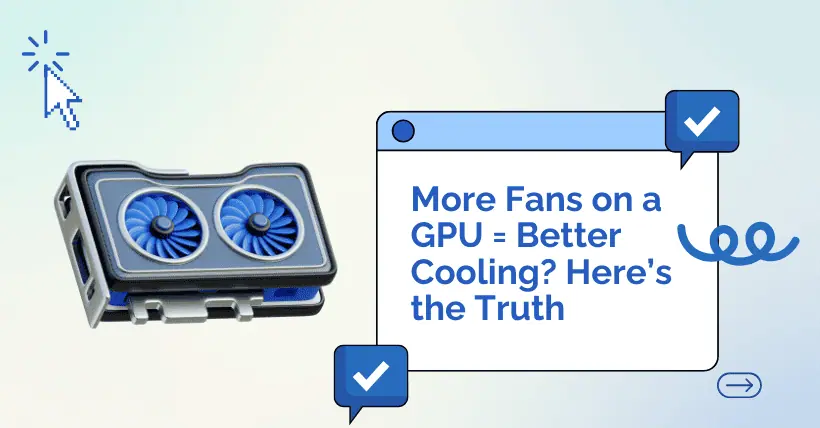The number of fans on a graphics card doesn’t necessarily correlate with better cooling performance. A single fan can sometimes outperform multiple fans, depending on the cooling design. The presence of more fans isn’t always about superior cooling—it can sometimes just be a cheaper solution for companies that can’t afford to use more advanced cooling technologies like vapor chambers or heat loop welding.
In fact, single-fan designs, especially blower-style fans, are considered more traditional and efficient for certain use cases. Multi-fan setups are more about catering to the gaming market and its specific demands.
1. Blower-style Fans vs. Standard Fans
A blower-style fan is designed to draw air in from the fan’s intake (usually the back of the card) and exhaust it out through the back panel, similar to a centrifugal pump. This ensures that heat is pushed out in a controlled direction. In contrast, standard axial fans blow air across the card’s surface, only in a forward direction.
Blower fans are usually encased in a shroud, directing airflow through the cooling fins and out of a single exhaust port at the back of the card. This design is highly efficient in multi-GPU setups because it avoids disrupting airflow in nearby PCIe slots. With blower-style cooling, you can stack multiple cards in close proximity without overheating issues because the heat is expelled directly out of the case, preventing heat buildup between cards.
2. Multi-fan Gaming GPUs
Modern gaming GPUs often feature two or three axial fans, which are large to minimize noise. These fans blow air downward onto the GPU’s heatsink. Once the airflow hits the PCB, it disperses in various directions, depending on the orientation of the heatsinks (upwards, downwards, left, or right).
The advantage of this design is that it provides a large intake and exhaust area, reducing airflow velocity and minimizing noise. However, the downside is that it requires more space for optimal airflow, often taking up three or more PCIe slots due to the card’s increased size and the need for additional cooling, like rear backplate fans. This can create issues in space-constrained setups by effectively occupying several PCIe slots.
3. PCIe Space Efficiency
From a motherboard space perspective, multi-fan designs can be problematic, as they often block adjacent PCIe slots. If you need to install additional cards like a sound card or network card, a triple-fan graphics card could be a hindrance. For users with dreams of running multi-GPU setups (e.g., 4-way SLI/Crossfire), this design is far from ideal.
However, for most modern users, this isn’t a major concern. The typical user only installs a single GPU, and airflow management inside the case isn’t as critical. As long as the GPU performs quietly and powerfully, the size and airflow design aren’t seen as major drawbacks.
This trend is reflected in Nvidia’s own Founders Edition (FE) designs, where even the RTX 20-series cards have adopted multi-fan setups to meet the demand for better cooling in gaming PCs, while still retaining a more refined and compact design compared to some bulkier aftermarket cards.
4. Blower-style for Workstation and Server Environments
For professional environments, such as AI research or rendering farms, where multiple GPUs are often installed side by side, blower-style cooling still reigns supreme. These environments often require tight spacing, and blower cards ensure that hot air is efficiently expelled from the case without affecting adjacent components. This is why Nvidia restricts the use of gaming GPUs for commercial computing tasks and why many high-end workstation GPUs come with premium blower-style cooling.
In conclusion, the number of fans isn’t the key determinant of cooling performance—design philosophy and usage scenario matter more. While gaming cards may favor multi-fan setups for noise control and cooling, blower-style fans are still the better choice in dense or high-performance computing environments where space and airflow control are critical.

Disclaimer:
- This channel does not make any representations or warranties regarding the availability, accuracy, timeliness, effectiveness, or completeness of any information posted. It hereby disclaims any liability or consequences arising from the use of the information.
- This channel is non-commercial and non-profit. The re-posted content does not signify endorsement of its views or responsibility for its authenticity. It does not intend to constitute any other guidance. This channel is not liable for any inaccuracies or errors in the re-posted or published information, directly or indirectly.
- Some data, materials, text, images, etc., used in this channel are sourced from the internet, and all reposts are duly credited to their sources. If you discover any work that infringes on your intellectual property rights or personal legal interests, please contact us, and we will promptly modify or remove it.



